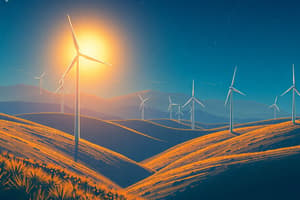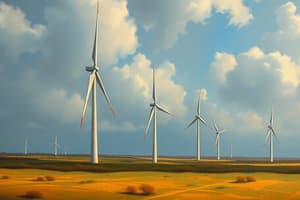Podcast
Questions and Answers
What is the typical size range of utility-scale wind turbines?
What is the typical size range of utility-scale wind turbines?
- 10 to 100 megawatts
- 1 to 10 megawatts
- 10 to 100 kilowatts
- 100 kilowatts to several megawatts (correct)
What is the main mechanism used to convert air motion into electricity in a wind turbine?
What is the main mechanism used to convert air motion into electricity in a wind turbine?
- Gearbox that converts rotational motion to electrical current
- Piezoelectric effect in the turbine blades
- Rotor blades that exert torque on a generator (correct)
- Electromagnetic induction in stationary coils
What is the primary advantage of offshore wind turbines compared to land-based turbines?
What is the primary advantage of offshore wind turbines compared to land-based turbines?
- Higher wind speeds and larger turbine size (correct)
- Lower construction costs
- Reduced environmental impact
- Easier installation and maintenance
Which of the following is NOT a type of wind power plant based on capacity?
Which of the following is NOT a type of wind power plant based on capacity?
How does the power output of a wind turbine depend on the wind speed?
How does the power output of a wind turbine depend on the wind speed?
Which of the following is NOT a direct use of the mechanical power generated by a wind turbine?
Which of the following is NOT a direct use of the mechanical power generated by a wind turbine?
What is the main advantage of distributed or 'small' wind turbines compared to utility-scale turbines?
What is the main advantage of distributed or 'small' wind turbines compared to utility-scale turbines?
Which of the following is a key challenge in integrating large amounts of wind power into the electric grid?
Which of the following is a key challenge in integrating large amounts of wind power into the electric grid?
What is the primary purpose of a wind turbine's gearbox?
What is the primary purpose of a wind turbine's gearbox?
Which of the following is a characteristic that makes a location well-suited for wind energy generation?
Which of the following is a characteristic that makes a location well-suited for wind energy generation?
Flashcards are hidden until you start studying
Study Notes
Wind Energy Introduction
- Wind power is a sustainable and renewable energy source that harnesses wind's kinetic energy to generate electricity.
- Any device capable of slowing down moving air, like a sail or propeller, can extract part of the energy and convert it into useful work.
Key Characteristics of a Good Wind Power Site
- High average wind speed
- Sufficient separation from noise-sensitive neighbors
- Good grid connection
- Good site access
- No special environmental or landscape designations
Wind Energy Basics
- Wind energy is a form of solar energy caused by the uneven heating of the atmosphere by the sun, variations in the earth's surface, and the rotation of the earth.
- Mountains, bodies of water, and vegetation influence wind flow patterns.
- Wind speeds vary based on geography, topography, and season.
- Aerodynamics is the study of the behavior of air as it interacts with solid objects.
Windmills vs. Wind Turbines
- Windmills have been used for centuries to grind grain, pump water, and do other work, but they do not generate electricity.
- Modern wind turbines are highly evolved machines with over 8,000 parts that harness wind's kinetic energy and convert it into electricity.
Wind Farms
- A wind farm is a collection of wind turbines built close together, functioning as a single power plant and sending electricity to the grid.
Components of a Wind Turbine
- Rotor blades capture the energy of the wind by rotating when subjected to the wind's force.
- Other components include a gearbox, high-speed shaft, and electrical generator that convert mechanical energy into electricity.
Types of Wind Power Plants
- Utility-scale wind: Wind turbines ranging from 100 kilowatts to several megawatts, delivering electricity to the power grid.
- Distributed or "small" wind: Single small wind turbines below 100 kilowatts, used to directly power a home, farm, or small business.
- Offshore wind: Wind turbines erected in large bodies of water, generating more power than land-based turbines.
Studying That Suits You
Use AI to generate personalized quizzes and flashcards to suit your learning preferences.




